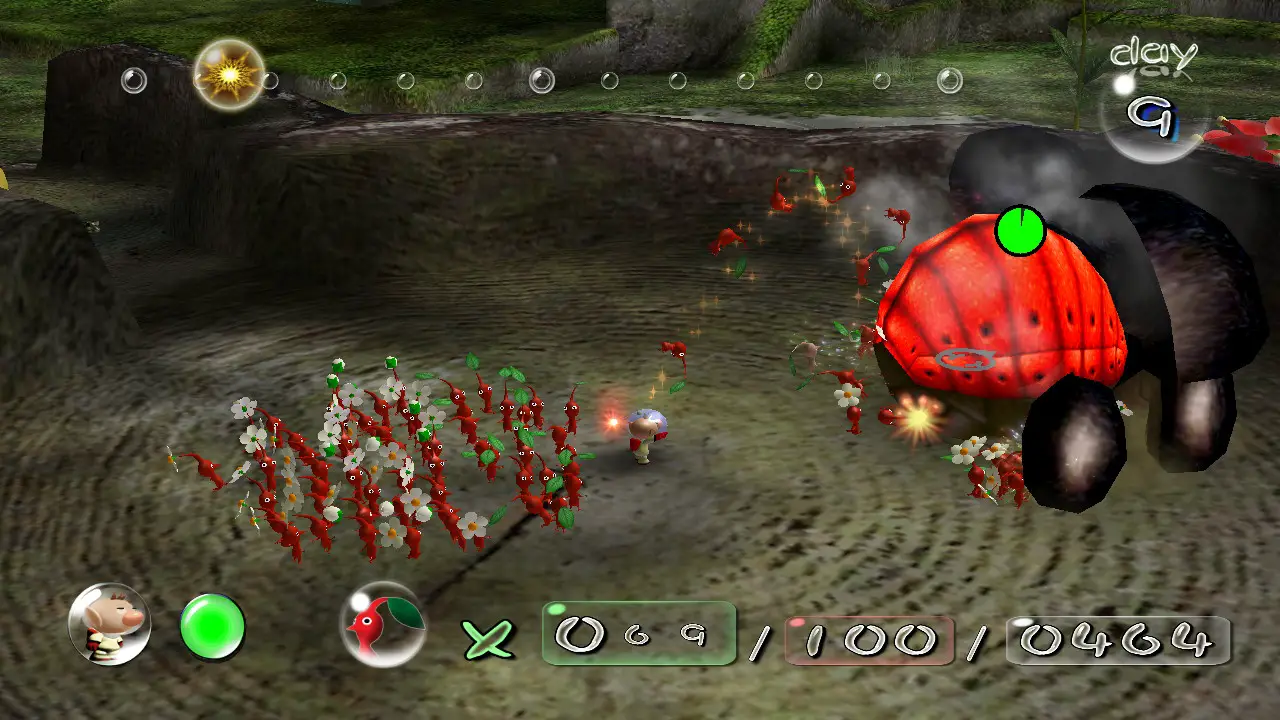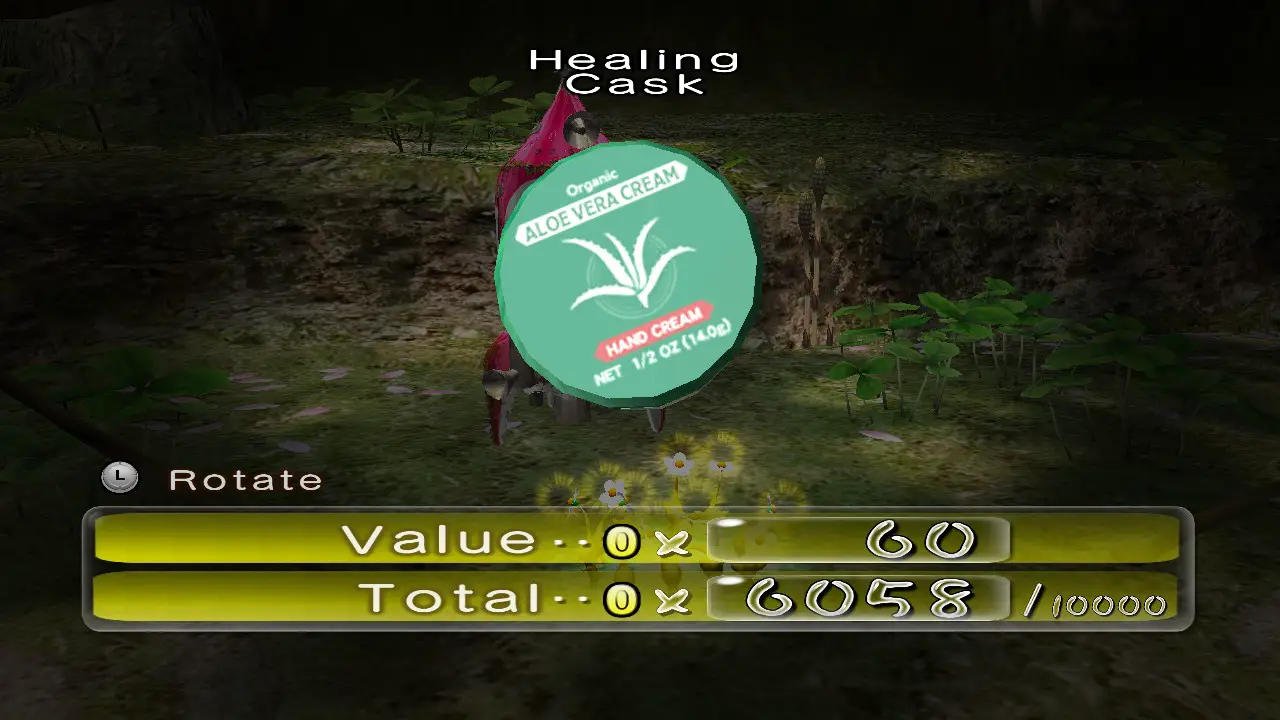
Pikmin is a weird franchise, even for Nintendo. Usually, behind each of their titles, you can find some core feeling or idea that the developers are trying to get across to the player. For Mario, this is the joy of movement and acrobatics, for Zelda it’s adventure, and for Metroid it’s a tense dive into the unknown. I find Pikmin much harder to parse in this regard, but having played 1, 2, and 3 several times over, with this new release of the GameCube classics I think I’ve come to a satisfying conclusion: improvisation.
That may seem counterintuitive, given that each game in the series encourages replays to complete the game as quickly as possible while losing the least amount of Pikmin. Ideally, you want to know where everything you need is and formulate a plan for each area to do everything as efficiently as possible, but as we all know even the best laid plans go wrong. Maybe you’re bringing back some treasure and suddenly a bomb falls from the ceiling or that Wollywog you were hoping to avoid jumps towards your group. The parts you remember in Pikmin aren’t those where everything goes according to play, it’s when everything goes wrong and you still succeed anyway.
If you’ve never played Pikmin before, here’s the lowdown on these ports of 1 and 2. In Pikmin 1, you play as Captain Olimar after he crash lands on an unknown planet. The crash caused 30 pieces of his ship, the Dolphin, to fly all over, and he only has 30 days to get them back before his life support systems run out and the planet’s deadly atmosphere of oxygen kills him. Luckily, he has the help of some native, plant-like creatures he names Pikmin. These helpers aren’t very smart or tough, but there’s strength in numbers, and they’re able to fight wildlife and carry objects on Olimar’s behalf.
Each in-game day sees you landing on the planet’s surface in a selected area to find ship parts, defeat enemies, solve environmental puzzles, and grow your numbers. You need to keep track of where all your Pikmin are and what they’re doing at all times, because once sunset comes, you’ll need to fly back up into the atmosphere for safety, and if any Pikmin aren’t in your squad or at base, they’ll be left behind to die. Sure you can always sprout more, but they’re just so darn cute you want to keep them safe.

Olimar can have up to 100 Pikmin in the field at one time. You direct Pikmin by throwing them, whether that be on an enemy to attack, at an object to carry back to base, near a bridge to build, or anything else you need. Using the left stick, you control both Olimar and the cursor to aim Pikmin, the A button will throw, B whistles causing Pikmin near the cursor to come back to you, and holding L while moving the right stick will have your squad swarm in the direction you’re aiming – useful for getting a large group on one task.
There are three types of Pikmin, with two more added in Pikmin 2. These are as follows: Red, which resist fire; Yellow, who can be thrown farther, carry bombs, and resist electricity in 2; Blue can breathe underwater; White are the fastest, resist poison, and can poison enemies; and Purple, which are the heaviest, can carry more individually, and stun enemies. Each type of Pikmin (aside from White and Purple) live in their respective Onions, strange spaceship-like objects. You can retrieve Pikmin by standing under the Onion, pressing A, then adding however many you want to your squad. You can also sprout new Pikmin by having a group of that color bring an enemy’s corpse back to the Onion, which will then shoot out seeds you can pluck from the ground after they sprout.
Pikmin 2 removes the time limit and instead has you chasing treasure to pay off your company’s debt. In addition to Olimar, you control a second Captain, Louie, and you can swap between the two at any time with Y. This allows for much easier multitasking, as you can have one Captain start a task then swap to the other while you wait. This game also introduced Caves, somewhat randomly generated dungeons where time stops and you want to collect all the treasure before moving on to the next floor. There’s still a lot more to these games, but those are the basics. Both are great games, though I still find Pikmin 2’s game design to be very hostile and mean spirited. So… how are these ports?
In short I find them very low effort. They look nicer since they’re in HD now, but I didn’t notice anything done to clean up the textures or improve the visuals. This means some visual quirks remain from the PAL Wii version, which this port is based on, such as Louie’s helmet clipping through the cockpit when flying off each day and menu boxes being far too big for what they contain. I also encountered some glitches in my playthrough of Pikmin 1 with Pikmin not going back into the Onion after being ordered to and even a few instances of Pikmin disappearing into thin air. Both games still run at 30 fps, which is also disappointing, but my main gripe with these ports is actually the controls.

I am of the opinion that the best way to play Pikmin was introduced in the New Play Control! rereleases on Wii, which allows you to control a captain and the cursor separately. Even Pikmin 3 Deluxe on Switch retained this control style, while still offering the option of more standard gamepad controls if you want. These ports don’t offer any other control schemes, in fact the only options you have other than volume are to turn motion controls on or off, which only activate when holding A or B. This makes motion almost useless and actually a hindrance most of the time because mashing A to throw will also activate them. Obviously your controller is moving when mashing, so if you’re trying to throw Pikmin across a gap, some may fall and die because of this motion. Since this is based on the Wii version, I don’t understand why true pointer controls were removed – it only serves to cement the New Play Control! Versions, one of which you can’t even buy in the US anymore since it never had a physical release, as definitive. They look worse, but not by a lot and they play MUCH better.
Frankly I’m astonished Nintendo is charging so much for these bare bones ports, when simply emulating them through a GameCube or Wii Virtual Console and including them in the NSO Expansion Pass would have earned them a lot more good will. Again, these are fantastic games and absolutely no game ever was released by “lazy developers”, but if you’re going to put basically no effort into them aside from removing 2’s product placement (which was very charming in other versions) and songs such as Ai No Uta, Tane No Uta, and even Totaka’s song, don’t sell them for almost full price as ports. I feel it shows a lack of respect for the original developers as well as the fans.
Pikmin 1
All Right
Pikmin 1 and 2 on Switch are the barest of bare bones ports. The clarity added by HD resolution and 16:9 support simply isn’t worth losing the improved controls of the Wii versions. In addition, these ports lose some of the original’s charm and contain strange glitches. While it’s great to have these games available on modern consoles, the Wii or GameCube releases are still the way to go if you can.
Pros
- HD and 16:9
- Two great games
Cons
- Worse control scheme
- Removed product placement
- Missing content such as songs
- Glitchy
